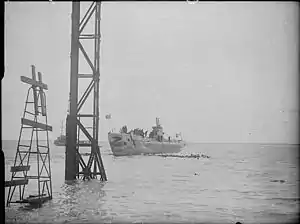HMS Auriga (P419)
HMS Auriga (P419/S69), was an Amphion-class submarine of the Royal Navy, built by Vickers Armstrong and launched 29 March 1945.[1]
 Auriga after launching | |
| History | |
|---|---|
| Name | Auriga |
| Builder | Vickers Armstrong, Barrow-in-Furness |
| Laid down | 7 June 1944 |
| Launched | 29 March 1945 |
| Commissioned | 12 January 1946 |
| Identification | Pennant number P419 |
| Fate | Sold to be broken up for scrap on 14 November 1974. Scrapped at Newport in February 1975. |
| General characteristics | |
| Class and type | Amphion-class submarine |
| Displacement | 1,360/1,590 tons (surface/submerged) |
| Length | 293 ft 6 in (89.46 m) |
| Beam | 22 ft 4 in (6.81 m) |
| Draught | 18 ft 1 in (5.51 m) |
| Propulsion | 2 × 2,150 hp (1,600 kW) Admiralty ML 8-cylinder diesel engine, 2 × 625 hp (466 kW) electric motors for submergence driving two shafts |
| Speed |
|
| Range |
|
| Test depth | 350 ft (110 m) |
| Complement | 60 |
| Armament |
|
Design
Auriga had a displacement of 1,360 long tons (1,380 t) when at the surface and 1,590 long tons (1,620 t) while submerged. It had a total length of 293 ft 6 in (89.46 m), a beam of 22 feet 4 inches (6.81 m), and a draught of 18 feet 1 inch (5.51 m). The submarine was powered by two Admiralty ML eight-cylinder diesel engines generating 2,150 horsepower (1,600 kW) each. Four electric motors each producing 625 horsepower (466 kW) drove two shafts.[2] It could carry a maximum of 219 long tons (223 t) of diesel, although it usually carried between 159 and 165 long tons (162 and 168 t).[2]
The submarine had a maximum surface speed of 18.5 knots (34.3 km/h) and a submerged speed of 8 knots (15 km/h).[3] When submerged, it could operate at 3 knots (5.6 km/h) for 90 nautical miles (170 km) or at 8 knots (15 km/h) for 16 nautical miles (30 km). Surfaced, it could travel 15,200 nautical miles (28,200 km) at 10 knots (19 km/h) or 10,500 nautical miles (19,400 km) at 11 knots (20 km/h).[2] Armament was ten 21-inch (533 mm) torpedo tubes, one QF 4 inch naval gun Mk XXIII, one Oerlikon 20 mm cannon, and a .303 British Vickers machine gun. Its torpedo tubes were fitted to the bow and stern, and it could carry twenty torpedoes. Its complement was sixty-one crew members.[2]
Service history
In 1953 she took part in the Fleet Review to celebrate the Coronation of Queen Elizabeth II.[4] In March 1961, the submarine was among the vessels that took part in a combined naval exercise with the United States Navy off Nova Scotia.[5] Auriga departed Canada on 25 April 1961 after completing an 18-month tour with the Sixth Submarine Division at Halifax, Nova Scotia.[6]
References
- "Agriga". Uboat.net. Retrieved 20 August 2015.
- Akermann, Paul (1 November 2002). Encyclopedia of British Submarines 1901-1955. Periscope Publishing Ltd. p. 422. ISBN 978-1-904381-05-1.
- "Acheron class". World Naval Ships, Cranston Fine Arts. Retrieved 20 August 2015.
- Souvenir Programme, Coronation Review of the Fleet, Spithead, 15 June 1953, HMSO, Gale and Polden
- "A/S Exercise Off Nova Scotia". The Crowsnest. Vol. 13, no. 6. Queen's Printer. April 1961. p. 2.
- "Auriga Returns to United Kingdom". The Crowsnest. Vol. 13, no. 7. Queen's Printer. May 1961. p. 3.
Publications
- Colledge, J. J.; Warlow, Ben (2006) [1969]. Ships of the Royal Navy: The Complete Record of all Fighting Ships of the Royal Navy (Rev. ed.). London: Chatham Publishing. ISBN 978-1-86176-281-8.